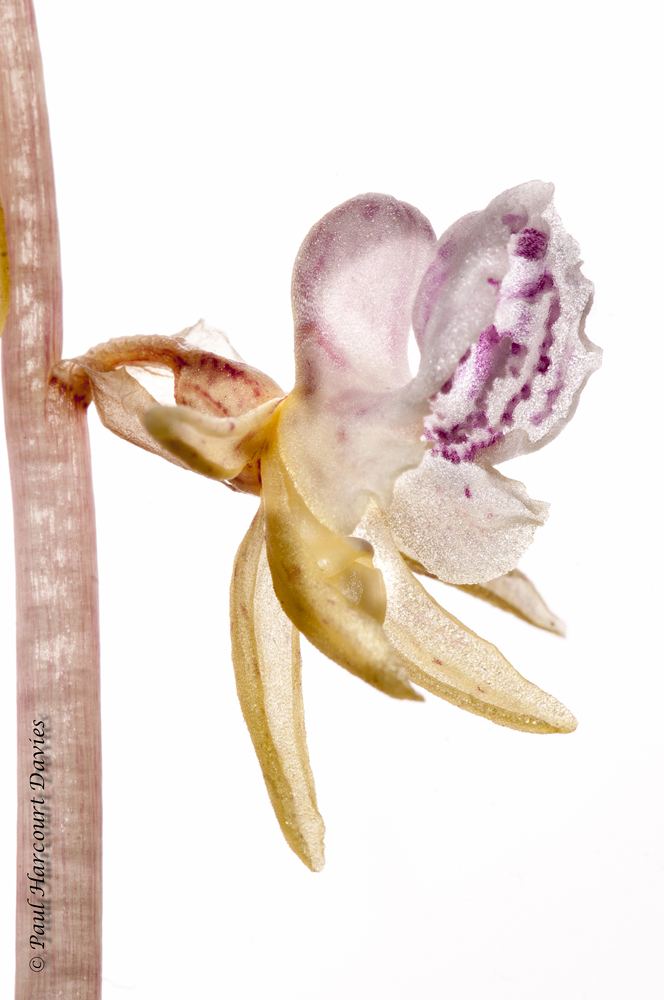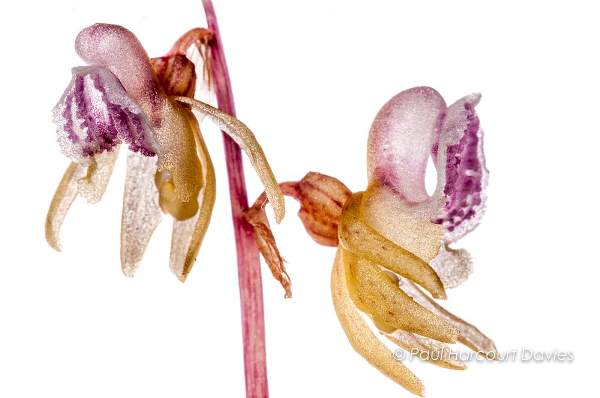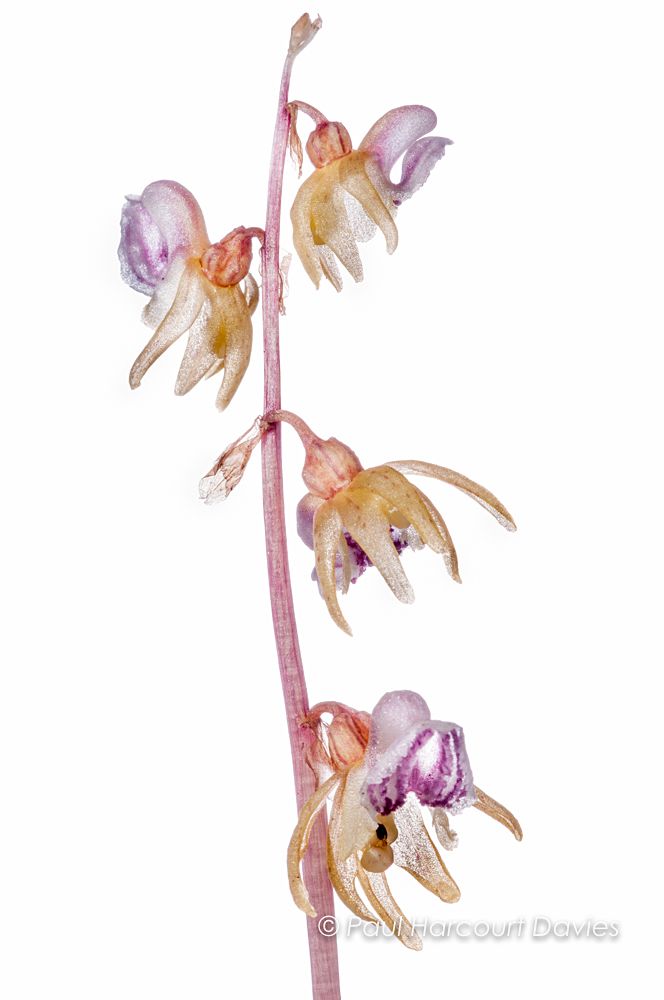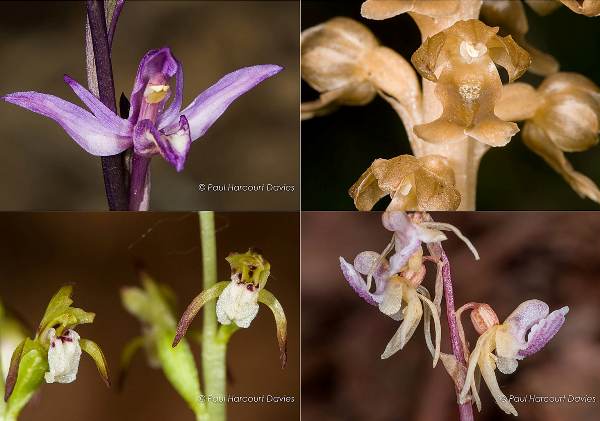Searching for the Ghost Orchid - history, identification and sites - Paul Harcourt Davies

Ghost Orchid flowers hang downwards but the lip points uppermost. Many European wild orchids have the lip downwards-pointing (resupinate) because the ovary is twisted through 180 degrees
Introduction
As I trudged uphill, through the thick beech leaf carpet, carrying rucksack and tripod I felt, instinctively, that this year - 2016 - would be far too dry for those tiny treasures, the ghost orchids. Over the years this elusive and unpredictable species has become a particular passion for me within the greater encompass of my Orchidophilia - a malady from which I have ‘suffered’ for half a century or so as a youngsters who first found bee orchids and could not believe how any flower could look like that.
The colouring of ghost orchids with various pale reddish browns, yellow and creamish tones creates a camouflage effect with the dappled lighting within their beechwood habitat. The knack is to spot the first when, as with orchids of all kinds, others then seem to spring up…as you become accustomed to the light and ‘get your ‘eye in’. This time, I had given up, resigned to trying another day and I took a slight diversion some 40m sideways from my path to a gully. With that capriciousness that characterises this and other orchid species, there was the first just a few centimetres high….another 9 spikes followed, flowering some two weeks earlier than I have ever found them previously in that locale.
The serious work then began with macro lenses of all sorts from wide to telephoto with natural light and flash whilst the large, persistent mosquitos found they had a new food source: me. One naturally has to suffer at times for one’s art but their vicious forays and persistence meant that a much higher proportion of images than usual had to be discarded at the later editing stage.

The most recent images I have of ghost orchids (July 2016) two weeks earlier than usual but deep in the beechwood gloom
As well as some images from this visit I have decided to dust off and revisit an article I wrote about four years ago that looks at my history with this orchid and gives an insight into what a love of a subject and a species can bring….
Way back in the mid 1960’s I was able to choose a book as a school biology prize and, having no idea of what it would eventually mean in my life, I chose V.S. Summerhayes’ classic Wild Orchids of Britain one of many classics in the Collins New Naturalist’s series. Although there here was much between its covers to fascinate an embryonic orchidomane it was hard not to be specially intrigued by Epipogium aphyllum, the ghost orchid, with its rarity and the sheer unpredictability of flowering.
Never in its evolutionary history can one imagine that the Ghost Orchid has been anything other than extremely uncommon at best: there were never woodland glades filled with this orchid growing like bluebells. Flowering is unpredictable in all its known localities throughout Europe into Asia and, though the pollination mechanism is effective, little seed is reputedly set.
There was some publicity (and not a small amount of hyperbole) that greeted, some years ago, the re-discovery by Mark Jannink of this species in the UK for the first time since 1986. It made me think back over some personal experiences and the results of informal and continuing researches in Europe since my own search began in 1976 when I was living in Wendover, Bucks . From what I know now, that memorably hot summer did not augur well for discovering the ghost orchid since it is generally accepted that sufficient rain in spring and early summer is essential since moisture stored in the rhizome stimulates the creation of the buds on the rhizome that will result in aerial stems. This can even be governed by conditions the year previously when buds are formed and stay dormant beneath ground. However, if conditions are too dry, the rhizome continues to grow but those buds (and even flowering stems) are aborted below ground .
The following year things looked better and I made weekly pilgrimages to a certain well known beechwood near the town of Marlow. I hasten to add that, at this stage, my trustworthiness had been tested and established through conservation work I had done and the powers that ran BBONT (The Berks, Bucks and Oxon Naturalists trust) at that time. I was finally entrusted with chapter and verse as to previous known beechwood locations.

Each time I went there I noticed at least one other person present and we both played that essentially British botanical game where each nonchalently pretends not to notice the other (although they know quite well why they are there...). What struck me then and since is that this and other locations were an open secret and, however well-meaning, people going to look for it could well have been (and I would suggest still are) the biggest threat to its survival as they shuffled in the beech mast, crushing nascent stems. The underground system with its rhizomes and stolons is not deeply situated and thus cannot be aided by general trampling. I found nothing in 1976 nor in 1977 making weekly visits from July to late September.
A telephone call in August 1978 alerted me to the discovery of a flowering stem that very day and the next, with precise directions, I was in the wood head down and searching in the gloom. Even then it was too late; there were no flowering stems but there were suspicious signs of the removal of a plant - the thieves had not even bothered to cover their traces and had left the hole. To say I was angry would be an understatement and I made careful enquiries and a ‘professional’ name kept being mentioned but there was no concrete proof. The general feeling was that, if proof of the theft were to be forthcoming, there could well be another large hole in the beechwood - this time filled with human material!
In September 1978 I left for a new life in Cyprus and, typically, in 1979 received a postcard to say that another spike had appeared and even that been removed. For normal folk it is hard to countenance the selfish obsessiveness of the very few. This exists with collectors of rare plants, birds’ eggs, butterflies…there is no thought for the welfare and survival of the species: they are probably mentally ill. My involvement in conservation has lasted for four decades and I have had direct experience of the depredations of some of these people and the steps to which they will go… even to the point of impersonation. Nowadays I treat requests (but not demands) for sites politely: in Italy many of the locations for rarities have been trusted to me and I am at the end of that chain and, I am sorry, but I will not break the trust.
The timeline in my tale shifts to 1985, though it is fair to say that in the interim I had found a fair few orchids and written a book…Wild Orchids of Britain & Europe with Anthony Huxley (1983). Now back in Britain, after a three year sojourn in Cyprus, I received a telephone call from Germany where a close friend told me that, in its classic site at Hüfingen in the Black Forest, there was a remarkable flowering. Such things are impossible to resist and that afternoon I took the first of several trains from S.Wales, a ferry to Ostend and an overnight train to Stuttgart…where, at 6am, I was greeted with a mug of hot coffee by German friends Ralf and Karin Berndt-Hansen. By 9am I was shaking with excitement - surrounded (well almost) by flowering stems of the ghost orchid.

The ghost orchid flower - showing all parts clearly: both lip and spur point upwards and you can see the short stem holding the ovary to the main flowering stem: it is non-resupinatet (ie not twisted through 180 degrees)
My very strong feelings about being European and the importance of widening interests (to get the British flora and fauna in proportion) also informs my political and social views on the EU. I detest narrow-minded nationalism, abhor that ‘little Islander’ mentality and love the diversity of different people, philosophies, outlooks and languages.
I know that some people feel a certain degree of ‘nationalism’ when it comes to orchids and feel they must see these things in Britain. In fact, back in the days when I did talks the length and breadth of the UK I was met one evening by a gentleman who asked me to let him know when I began to talk about orchids beyond Europe’s shores because he was only interested in UK orchids… I tried to explain that it was only by viewing our impoverished UK flora, that one could understand the evolution and effects of human pressures on the orchid population… not to say other species of plants and animals. He was unmoved…and the loser for it, I believe.
I have long taken the attitude that I do not want to add my weight to the numbers going to see orchids where they are endangered, thus helping to ensure their demise. In Germany in an ancient pinewood, a wonderful colony of these exquisite ghost orchids survived (and still does) Locals know the site well and the fact that, across the road in another part of the wood, grow large numbers of lady's slipper flowering a couple of months earlier. There is great local pride taken in their protection.
Some observations…

A pair of ghost orchid flowers against a white background
In Germany I had a first opportunity to study the orchids at close quarters and at leisure, noting the distinctive scent I had read about in old books. It has been alternately described as sweet or foetid and resembling fermenting pineapples. This shows the unreliability of olfactory descriptions – to me it was distinctly sweet: I could not swear to either honey or pineapple tones, I don’t have that kind of nose. It may be worth pointing out that, although the wood at Hüfingen is of ancient pine it is not gloomy everywhere within like the UK beechwood sites –all the continental plants I have found either growing in beechwood/ mixed broadleaf or under pine were often growing in lighter conditions, even at woodland edges where sparse grass was able to grow.
In every case the host woods have been long-established and the orchid plants found have usually been where there is water close by in winter – a wet area in a wood, a ditch and so on. The substrate has always been calcareous but a plant’s immediate environment will be slightly acidic from the decaying leaf material.
As a saprophyte, any need for light would be questionable, especially since there are records of flowers being produced underground. This is accidental – probably an aborted spike since the pollinators do not burrow, unlike two fascinating Australian species in the genus Rhizanthella that always flower underground.
There is always a conundrum with those few wild orchid species in Europe that are considered saprophytic in that all orchids depend at some stage in their life on the relationship with a mycorrhiza fungus, often more a ding-dong battle for survival in the early stages than symbiosis. Many orchids growing in woodlands will revert to fungal dependence when light levels drop and push up no more than a profile as a kind of ‘periscope’. Indeed when the fungal mycelia penetrate the germinating orchid seed, (the seed itself is more or less a nucleus in a protective sheath) the chemicals secreted start to digest the ends of the mycelium within it turning them into ball like knots called ‘plotons’ that the plant then digests…a mix of parasitism and saprophytic activity.

Spikes of the ghost orchid are often very small (less than 10cm in height) and with few flowers 2-3 for example
Although I have not been back to the Hüfingen site, I have happened by chance upon ghost orchid plants several times since -always in mountain regions of Europe. You get a ‘feel’ for the kind of wood – the pinewoods have plenty of moss, the beech with an abundance of leaf litter with woodland species such as the wintergreens (Pyrolas) and other orchid taxa such as various Epipactis and, by flowering time the seed-bearing stems of bird’s nest orchid (Neottia nidus-avis) and yellow bird’s nest (Monotropa hypopitys) I can recall several chance finds in long established pine and mixed woods in the Dolomites.
To the Present Day
Whilst living in Italy I have (for seven years in succession) visited several known sites often with Italian friends who, themselves, have been searching for decades. I cannot express too strongly my gratitude for the generosity and companionship of Pier-luigi Pacetti and Pino Rattini…not to forget the improvements to my spoken Italian.
It does not matter where this orchid grows, it capriciousness seems universal…there are no guarantees of success and I never start off a day's hike with anything more than mild hope. With climatic conditions everywhere in Europe now highly unpredictable the chances of a wet spring are slim, but even when there is rain at what you might tentatively think was the right time flowering is, to say the least, uncertain.
There is one superb location in the Apennines some 2.5 hours journey from where we live. that demands hauling whatever photographic equipment you have for a good 90 minutes uphill in the heat. But when you get to a beechwood where a stream runs across the path in winter fatigue evaporates, when in the dappled light you glimpse the prize, trust me, I know. Spikes of ghost orchid have been seen on one occasion in four visits - what was particularly worrying was the apparent level of activity from wild boar which in Italy seem to have a love of orchid roots and tubers irrespective of rarity and are a major threat to their survival.
Another site on Mt Amiata, the highest mountain in Tuscany, has yielded a single flowering spike on one occasion. A far better and more reliable site in Abruzzo (the one I returned to yesterday on 13th July 2016) has provide at least a handful and more of spikes on each of the five occasions I have visited it.
The future
In continental Europe sites can be threatened by logging and, ultimately, by climate change. It is almost impossible to tell the extent of this and thus of the exact distribution of the species given the known irregularity of flowering. There are numerous recorded instances of Epipogium aphyllum appearing after long absences (as in the UK) most likely from underground parts that have persisted unnoticed.
E. aphyllum is not an easy orchid to find for it blends well with leaf litter on the woodland floor where there is dappled light - the name ghost orchid is apt.The difficulty in ever knowing with any degree of accuracy the distribution of a species like this is that numerous visits have to be made over a potentially lengthy flowering period in successive years…serendipity is a great friend of orchid lovers.
Some Plant facts
Flowers
The ghost orchid is an extremely attractive plant, irrespective of its almost legendary status as a rarity. The flowers are large for the overall size of the orchid (often less than 10cm tall…) slightly pendent and delicately hued. The lip has a crinkled margin with a large, triangular central lobe, it is whitish to delicate rose pink with purple papillae on its inner surface. white and delicately marked with rose pink whilst sepals are yellowish. and then there is that scent, delicate but sweet. There are purple streaks on the outer surface and on the rather fat spur.
Pollination
Small humble bees are said to be the most successful pollinators as their size is just right to effect pollination .The bee lands on the exposed part of the lip and makes its way towards the spur where it can reach the nectar. As it backs out it ruptures the delicate rostellum, the anther cap is pulled away and the pollinia are exposed – these stick to the head parts of the bee.
Very few seed capsules are produced in the UK (R.A Graham noted one in a group of 22 flowering stems he chanced upon). I have seen a few capsules where the plants grew in lighter cover in larger colonies in Italy and Germany where, presumably, there was an increased chance of a productive insect encounter.
Distribution
E. aphyllum is a Eurasian species extending from Europe through Russia east to Japan and one of two known species in the genus Epipogium – the other, E. roseum has a wide distribution throughout the tropical regions of the world. The ghost orchid was first discovered in the UK in 1854 by Mrs W. Anderton near Tedstone Delamere and in 1876 nr Ludlow. The Oxfordshire plants were first noted in 1923…
Name
The name derives from Epi (on) and pogon (a beard or lip). In the literature I have to hand the following diverse list of alternatives appears…there may be others. No-one seemed quite sure of where to put it in the taxonomic scheme of things. The first record I can find is from Siberia (1747)
1. Satyrium epipogium L. (1753)
2. Orchis aphylla F.W. Schmidt (1791)
3. Epipactis epipogium (L.) All. (1789)
4. Limodorum epipogium (L.) Sw. (1799)
5. Epipogium aphyllum Sw (1814)
6. Epipogium gmelinii Rich. (1817)
7. Serapias epigogium (L.) Steud. (1821)
8. Epipogium epipogium (L.) H. Karst. (1881)
9. Epipogium generalis E.H.L. Krause (1905)
